|
|
|
|
|
Oil On
Canvas, Real Flavor of Old Masters
|
|

|
ARTWORKS
INDEX
A B C D E F G H I J K L M N O P Q R S T U V W X Y Z |
ARTISTS
INDEX
A B C D E F G H I J K L M N O P Q R S T U V W X Y Z |
|
|
| | |
|
|
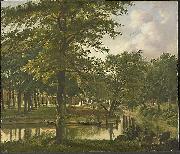 |
Wybrand Hendriks -- Click Here
|
|
(June 24, 1744, Amsterdam - January 28, 1831, Haarlem), was a Dutch painter and the concierge of the Teylers Museum.
According to the RKD he learned to paint while working for the decorative wall paper factory of J. Remmers in Amsterdam. From 1786 to 1819 he was the second concierge ("kastelein") of the Teyler's Stichting in Haarlem, where he lived at the "Fundatiehuis" as curator of the art collection, with his studio in the old drawing room of Teyler's drawing academy, which had itself been moved to the city hall. He assumed the position in 1785 after his predecessor Vincent Jansz van der Vinne had left in disagreement with Martin van Marum, the head of the fossil and instrument collections. As curator, he managed to purchase an important collection of Italian drawings from the collection of Queen Christina of Sweden in 1790.
He is known for portraits, landscapes, and flower still lifes in the manner of Jan van Huysum.
|
|
 |
Wolfgang Heimbach -- Click Here
|
|
c.1600/1615-after 1678, German painter. The son of a bookkeeper at the corn exchange, he was known because of a disability as 'the Ovelg?nne mute'. An aristocratic sponsor, probably Graf Anton G?nther (1603-67) of Oldenburg, sent him to train in the Netherlands: stylistic considerations would suggest that this was in the 1630s. The Evening Scene (1637; ex-art market, Berlin; G?ttsche, no. 8) shows him adapting the style of Caravaggio as practised in Utrecht to the kind of social gathering depicted by Dirck Hals or Anthonie Palamedesz. He uses an artificial light source to exaggerate the modelling of the figures and the space. This characteristic of his art also shows in the Evening Banquet of 1640 |
|
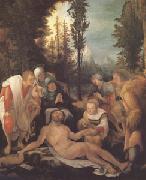 |
Wolf Huber -- Click Here
|
|
Feldkirch ca 1480-Passau 1553 |
|
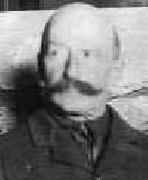 |
Winslow Homer -- Click Here
|
|
1836-1910
Winslow Homer Locations
Winslow Homer (February 24, 1836 ?C September 29, 1910) was an American landscape painter and printmaker, best known for his marine subjects. He is considered one of the foremost painters in 19th century America and a preeminent figure in American art.
Largely self-taught, Homer began his career working as a commercial illustrator. He subsequently took up oil painting and produced major studio works characterized by the weight and density he exploited from the medium. He also worked extensively in watercolor, creating a fluid and prolific oeuvre, primarily chronicling his working vacations. |
|
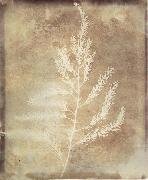 |
Willim Henry Fox Talbot -- Click Here
|
|
British, 1800-1877
|
|
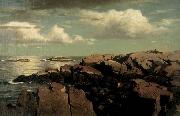 |
William Stanley Haseltine -- Click Here
|
|
(June 11, 1835-February 3, 1900) was an American painter and draftsman who was associated with the Hudson River School and Luminism.
Born in Philadelphia to John Haseltine, a successful businessman, and Elizabeth Shinn Haseltine, an amateur landscape painter, Haseltine studied at the University of Pennsylvania and then at Harvard University, where he received a degree in 1854.
He first exhibited his paintings the following year at the Pennsylvania Academy of Fine Arts, after which he sailed to Europe, first joining a colony of American painters who were studying in Dusseldorf, then traveling up the Rhine into Switzerland and Italy. In late 1857 he settled in Rome, and in the following months made numerous excursions to draw the landscape around Rome and on Capri.
In 1858 Haseltine returned to Philadelphia, and by late 1859 was installed in the Tenth Street Studio Building in New York City, then a central point for American landscape painters; also in the building were Frederic Edwin Church, Albert Bierstadt, and Worthington Whittredge, the latter two having befriended Haseltine in Europe. Though many of his paintings from this time derived from his European sketches, Haseltine also began to paint the oceanside of New England, especially favoring the rockbound coasts of Narragansett, Rhode Island, Nahant, Massachusetts, and Mount Desert Island, Maine. The precision with which he painted these landscapes won critical praise, and Haseltine was elected an Associate of the National Academy of Design in 1860, and a full Academician in 1861.
In 1864 Haseltine's wife died in childbirth. He spent some time training his nephew, Howard Russell Butler, but he moved after he married Helen Marshall in 1866. Initially the family considered settling in Paris, but in 1867 they moved to Rome, which would for most of Haseltine's subsequent years serve as his home and point of departure from which to produce views of the European landscape. While his paintings of Capri and Sicily would prove popular with visiting American tourists, Haseltine also traveled and drew in France, Holland, Belgium, and the Netherlands, summering in Bavaria and the Tyrol in the 1880s and 1890s. In his later years he also returned periodically to the United States, making a final trip to the west in 1899.
Haseltine died of pneumonia in Rome in 1900. |
|
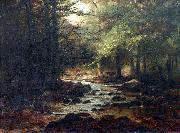 |
William Samuel Horton -- Click Here
|
|
painted Landscape with Stream in c. 1900
|
|
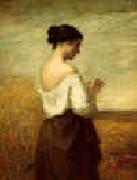 |
William Morris Hunt -- Click Here
|
|
1824- 1879
William Morris Hunt Gallery
Hunt's father's family were among Vermont's founders and largest landowners; his mother's a family of wealth and prominence in Connecticut. Hunt attended Harvard but withdrew in his junior year.
Following the untimely death of his Congressman father from cholera, Hunt's mother Jane took him and his brothers to Switzerland, the South of France and to Rome, where Hunt studied with Couture in Paris and then came under the influence of Jean-François Millet, from whom he learned the principles of the Barbizon school. The Hunt family remained in Europe for a dozen years.
Afterwards, leaving Paris, he painted and established art schools at Newport, Rhode Island, where he had relatives, Brattleboro, Vermont, Faial Island in the Azores, where he had family connections and finally at Boston, where he painted, taught art and became a popular portrait painter.
The companionship of Millet had a lasting influence on Hunt's character and style, and his work grew in strength, in beauty and in seriousness. He was among the biggest proponents of the Barbizon school in America, and he more than any other turned the rising generation of American painters towards Paris.
On his return in 1855 he painted some of his most handsome canvases, all reminiscent of his life in France and of Millet's influence. Such are The Belated Kid, Girl at the Fountain, Hurdy-Gurdy Boy, and others ?C but the public called for portraits, and it became the fashion to sit for Hunt; among his best paintings of this genre are those of William M. Evarts, Mrs Charles Francis Adams, the Rev. James Freeman Clarke, William H. Gardner, Chief Justice Shaw and Judge Horace Gray.
Sadly, many of Hunt's paintings and sketches, together with five large Millets and other art treasures collected by him in Europe, were destroyed in the Great Boston Fire of 1872. |
|
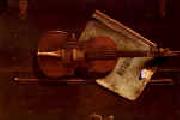 |
William Michael Harnett -- Click Here
|
|
1851-1892
Harnett was born in Clonakilty, County Cork, Ireland during the time of the potato famine. Shortly after his birth his family emigrated to America, settling in Philadelphia. Becoming a United States citizen in 1868, he made a living as a young man by engraving designs on table silver, while also taking night classes at the Pennsylvania Academy of the Fine Arts and later, in New York, at Cooper Union and at the National Academy of Design. His first known oil painting, a still life, dates from 1874.
The style of trompe l'oeil painting that Harnett developed was distinctive and inspired many imitators, but it was not without precedent. A number of 17th century Dutch painters, Pieter Claesz. for instance, had specialized in tabletop still life of astonishing verisimilitude. Raphaelle Peale, working in Philadelphia in the early 19th century, pioneered the form in America. What sets Harnett's work apart, besides his enormous skill, is his interest in depicting objects not usually made the subject of a painting.
Harnett painted musical instruments, hanging game, and tankards, but also painted the unconventional Golden Horseshoe (1886), a single rusted horseshoe shown nailed to a board. He painted a casual jumble of second-hand books set on top of a crate, Job Lot, Cheap (1878), as well as firearms and even paper currency. His works sold well, but they were more likely to be found hanging in a tavern or a business office than in a museum, as they did not conform to contemporary notions of high art.
Harnett spent the years 1880?C1886 in Europe, staying in Munich from 1881 until early 1885. Harnett's best-known paintings, the four versions of After The Hunt, were painted between 1883 and 1885. Each is an imposing composition of hunting equipment and dead game, hanging on a door with ornate hinges at the right and keyhole plate at the left. These paintings, like the horseshoe or currency depictions mentioned earlier, are especially effective as trompe l'oeil because the objects occupy a shallow space, meaning that the illusion is not spoiled by parallax shift if the viewer moves.
Overall, Harnett's work is most comparable to that of the slightly younger John F. Peto. The two artists knew each other, and a comparison can be made between two paintings featuring violins. Harnett's Music and Good Luck from 1888 shows the violin hanging upright on a door with ornate hinges and with a slightly torn piece of sheet music behind it. The elements are arranged in a stable, deliberate manner. Peto's 1890 painting shows the violin hanging askew, as well as chipped and worn, with one string broken. The sheet music is dog-eared and torn around the edges, and placed haphazardly behind the instrument. The hinges are less ornate, and one is broken. Harnett's objects show signs of use but are well preserved, while Peto's more humble objects are nearly used up.
Crippling rheumatism plagued Harnett in his last years, reducing the number but not the quality of his paintings. He died in New York City in 1892. Other artists who painted similar compositions in Harnett's wake include his contemporary John Haberle and successors such as Otis Kaye and Jefferson David Chalfant. |
|
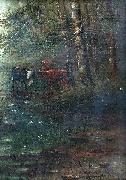 |
William M. Hanna -- Click Here
|
|
painted Woodland View With Cows in c. 1879
|
|
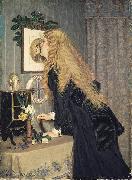 |
William John Hennessy -- Click Here
|
|
(July 11, 1839 - December 27, 1917) was an Irish artist.
William John Hennessy was born in Thomastown, County Kilkenny in 1839. His father, John Hennessy, was forced to leave Ireland in 1848 as a result of his involvement in the Young Ireland movement. He landed in Canada and settled in New York. William, his mother Catherine, and brother joined their father there in 1849. He gained admittance to the National Academy of Design in 1854 and exhibitioned his first works there.
Hennessy developed a skill in wood engraving and was hired to illustrate the works of renowned poets, including that of Tennyson, Longfellow and Whittier. As an American he became the co-founder of the Artists Fund Society, and an honorary member of the American Society of Painters in Watercolours. In 1870 he moved to London where he became a member of the Royal Institute of Oil Painters in 1902. Between 1879 and 1907 the Royal Hibernian Academy displayed eight of his paintings.
|
|
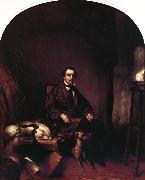 |
William James Hubard -- Click Here
|
|
British/American Artist , Silhouettist , Sculptor, and Scientist , 1807-1862 |
|
|
|
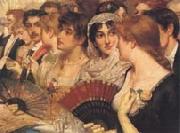 |
William Holyoake -- Click Here
|
|
British genre and historical painter , 1834-1894 |
|
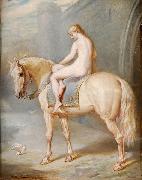 |
William Holmes Sullivan -- Click Here
|
|
painted Lady Godiva in 1877 |
|
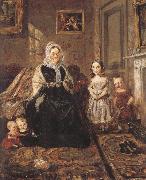 |
william holman hunt,o.m.,r.w.s -- Click Here
|
|
1827-1910
English painter. He worked as an office clerk in London from 1839 to 1843, attending drawing classes at a mechanics' institute in the evenings and taking weekly lessons from the portrait painter Henry Rogers. Holman Hunt overcame parental opposition to his choice of career in 1843, and this determined attitude and dedication to art could be seen throughout his working life. In July 1844, at the third attempt, he entered the Royal Academy Schools. His earliest exhibited works, such as Little Nell and her Grandfather (exh. British Institution, 1846; Sheffield, Graves A.G.), reveal few traces of originality, but the reading of John Ruskin's Modern Painters in 1847 was of crucial importance to Holman Hunt's artistic development. It led him to abandon the ambitious Christ and the Two Marys (Adelaide, A.G. S. Australia) in early 1848, when he realized its traditional iconography would leave his contemporaries unmoved. His next major work, the Flight of Madeline and Porphyro during the Drunkenness Attending the Revelry (1848; London, Guildhall A.G.), from John Keats's 'Eve of St Agnes', though displaced into a medieval setting, dramatized an issue dear to contemporary poets and central to Holman Hunt's art: love and youthful idealism versus loyalty to one's family. His first mature painting, it focuses on a moment of psychological crisis in a cramped and shallow picture space. |
|
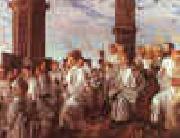 |
William Holman Hunt -- Click Here
|
|
1827-1910
British
William Holman Hunt Galleries
Hunt's intended middle name was "Hobman", which he disliked intensely. He chose to call himself Holman when he discovered that his middle name had been misspelled this way after a clerical error at his baptism at the church of Saint Mary the Virgin, Ewell.[1] Though his surname is "Hunt", his fame in later life led to the inclusion of his middle name as part of his surname, in the hyphenated form "Holman-Hunt", by which his children were known.
After eventually entering the Royal Academy art schools, having initially been rejected, Hunt rebelled against the influence of its founder Sir Joshua Reynolds. He formed the Pre-Raphaelite movement in 1848, after meeting the poet and artist Dante Gabriel Rossetti. Along with John Everett Millais they sought to revitalise art by emphasising the detailed observation of the natural world in a spirit of quasi-religious devotion to truth. This religious approach was influenced by the spiritual qualities of medieval art, in opposition to the alleged rationalism of the Renaissance embodied by Raphael. He had many pupils including Robert Braithwaite Martineau (best known for his work "Last Days in the Old Home") who was a moderately successful painter although he died young.
The Hireling Shepherd, 1851Hunt's works were not initially successful, and were widely attacked in the art press for their alleged clumsiness and ugliness. He achieved some early note for his intensely naturalistic scenes of modern rural and urban life, such as The Hireling Shepherd and The Awakening Conscience. However, it was with his religious paintings that he became famous, initially The Light of the World (now in the chapel at Keble College, Oxford, with a later copy in St Paul's Cathedral), having toured the world. After travelling to the Holy Land in search of accurate topographical and ethnographical material for further religious works, Hunt painted The Scapegoat, The Finding of the Saviour in the Temple and The Shadow of Death, along with many landscapes of the region. Hunt also painted many works based on poems, such as Isabella and The Lady of Shalott.
All these paintings were notable for their great attention to detail, their hard vivid colour and their elaborate symbolism. These features were influenced by the writings of John Ruskin and Thomas Carlyle, according to whom the world itself should be read as a system of visual signs. For Hunt it was the duty of the artist to reveal the correspondence between sign and fact. Out of all the members of the Pre-Raphaelite Brotherhood Hunt remained most true to their ideals throughout his career. He eventually had to give up painting because failing eyesight meant that he could not get the level of quality that he wanted. His last major work, The Lady of Shalott, was completed with the help of an assistant (Edward Robert Hughes).
Hunt married twice. After a failed engagement to his model Annie Miller, he married Fanny Waugh, who later modelled for the figure of Isabella. When she died in childbirth in Italy he sculpted her tomb up at Fiesole, having it brought down to the English Cemetery, beside the tomb of Elizabeth Barrett Browning. His second wife, Edith, was Fanny's sister. At this time it was illegal in Britain to marry one's deceased wife's sister, so Hunt was forced to travel abroad to marry her. This led to a serious breach with other family members, notably his former Pre-Raphaelite colleague Thomas Woolner, who had married Fanny and Edith's third sister Alice.
Hunt's autobiography Pre-Raphaelitism and the Pre-Raphaelite Brotherhood (1905) was written to correct other literature about the origins of the Brotherhood, which in his view did not adequately recognise his own contribution. Many of his late writings are attempts to control the interpretation of his work.
In 1905, he was appointed to the Order of Merit by King Edward VII. At the end of his life he lived in Sonning-on-Thames. |
|
 |
William Holbrook Beard -- Click Here
|
|
1824-1900
William Holbrook Beard Gallery |
|
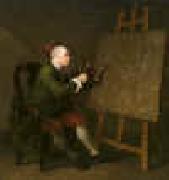 |
William Hogarth -- Click Here
|
|
British
1697-1764
William Hogarth Galleries
Early satirical works included an Emblematical Print on the South Sea Scheme (c.1721), about the disastrous stock market crash of 1720 known as the South Sea Bubble, in which many English people lost a great deal of money. In the bottom left corner, he shows Protestant, Catholic, and Jewish figures gambling, while in the middle there is a huge machine, like a merry-go-round, which people are boarding. At the top is a goat, written below which is "Who'l Ride" and this shows the stupidity of people in following the crowd in buying stock in The South Sea Company, which spent more time issuing stock than anything else. The people are scattered around the picture with a real sense of disorder, which represented the confusion. The progress of the well dressed people towards the ride in the middle shows how foolish some people could be, which is not entirely their own fault.
Other early works include The Lottery (1724); The Mystery of Masonry brought to Light by the Gormogons (1724); A Just View of the British Stage (1724); some book illustrations; and the small print, Masquerades and Operas (1724). The latter is a satire on contemporary follies, such as the masquerades of the Swiss impresario John James Heidegger, the popular Italian opera singers, John Rich's pantomimes at Lincoln's Inn Fields, and the exaggerated popularity of Lord Burlington's prot??g??, the architect and painter William Kent. He continued that theme in 1727, with the Large Masquerade Ticket. In 1726 Hogarth prepared twelve large engravings for Samuel Butler's Hudibras. These he himself valued highly, and are among his best book illustrations.
In the following years he turned his attention to the production of small "conversation pieces" (i.e., groups in oil of full-length portraits from 12 to 15 in. high). Among his efforts in oil between 1728 and 1732 were The Fountaine Family (c.1730), The Assembly at Wanstead House, The House of Commons examining Bambridge, and several pictures of the chief actors in John Gay's popular The Beggar's Opera.
One of his masterpieces of this period is the depiction of an amateur performance of John Dryden's The Indian Emperor, or The Conquest of Mexico (1732?C1735) at the home of John Conduitt, master of the mint, in St George's Street, Hanover Square.
Hogarth's other works in the 1730s include A Midnight Modern Conversation (1733), Southwark Fair (1733), The Sleeping Congregation (1736), Before and After (1736), Scholars at a Lecture (1736), The Company of Undertakers (Consultation of Quacks) (1736), The Distrest Poet (1736), The Four Times of the Day (1738), and Strolling Actresses Dressing in a Barn (1738). He may also have printed Burlington Gate (1731), evoked by Alexander Pope's Epistle to Lord Burlington, and defending Lord Chandos, who is therein satirized. This print gave great offence, and was suppressed (some modern authorities, however, no longer attribute this to Hogarth). |
|
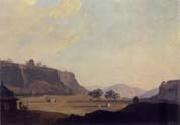 |
William Hodges -- Click Here
|
|
English Painter, 1744-1797
English painter. He first attended classes at William Shipley's Academy in the Strand, London, and from 1758 to 1765 was apprenticed to Richard Wilson (about whom he published a short biographical essay in 1790). Hodges followed Wilson's classical landscape style periodically throughout his career. |
|
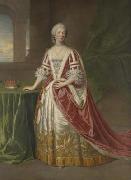 |
William Hoare -- Click Here
|
|
William Hoare of Bath RA (c. 1707 - 12 December 1792) was an English painter and printmaker, co-founder of the Royal Academy noted for his pastels.
Born near Eye, Suffolk, Hoare received a gentlemanes education in Faringdon. He showed a marked aptitude for drawing and was sent to London to study under Giuseppe Grisoni, who had left Florence for London in 1715. When Grisoni returned to Italy in 1728, Hoare went with him, travelling to Rome and continuing his studies under the direction of Francesco Imperiali. He remained in Rome for nine years, returning to London in 1737/8.
Failing to establish himself in London, Hoare settled in Bath, an expanding spa town popular with the wealthier classes. He obtained numerous commissions, the most important being for official portraits of social leaders of the day (including George Frideric Handel) and political men. There are several versions of most of these, suggesting that he had a studio, and they were further publicised by the production of mezzotints by leading engravers of the day. Hoare himself was a delicate etcher and published a number of private plates, mostly of family and friends, including Miss Hoare (probably Mary), Christopher Anstey and the 3rd Duke of Beaufort. His pastels were influenced by Rosalba Carriera. |
|
|
|
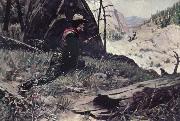 |
William Herbert Dunton -- Click Here
|
|
a self-taught artist . American Painter , 1878-1936
was an American artist who was one of the founding members of the Taos Society of Artists and part of the Taos art colony. He first came to Taos, New Mexico, in 1912. Among his proteges in Western art was Harold Dow Bugbee of Clarendon and Canyon in the Texas Panhandle. |
|
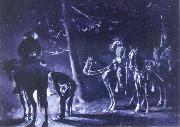 |
William Henry Shelton -- Click Here
|
|
A nineteenth century painter, etcher and illustrator.
American , 1840-1932
|
|
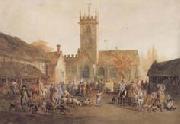 |
William Henry Pyne -- Click Here
|
|
English Painter, 1769-1843
English painter, illustrator and writer. He trained at the drawing academy of Henry Pars (c. 1733-1806) in London and first exhibited at the Royal Academy in 1790. His drawings were almost always pen, ink and colour wash (e.g. Gossip at the Cottage Door, 1794; London, BM). His most characteristic works are the illustrations for the books Microcosm (1803-8) and The Costume of Great Britain (1808) in which he successfully placed groups of well-observed characters in picturesque settings. Pyne had been a founder of the Old Water-Colour Society in 1804 but resigned in 1809 when it refused to increase its membership to greater than 24 artists. |
|
|
|
|
|
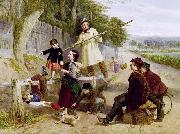 |
William Henry Knight -- Click Here
|
|
(26 September 1823 - 31 July 1863) was an English portrait and genre painter.
Knight was born in Newbury, Berkshire where his father, John Knight, was a schoolmaster. He was to become a solicitor, but gave up his law studies after two of his paintings were accepted by the annual exhibition of the Society of British Artists. He moved to London in 1855, taking lodgings in Kennington Road, Lambeth, and supporting himself by drawing crayon portraits while studying in the British Museum and in the schools of the Royal Academy.
|
|
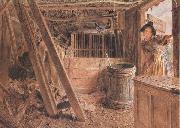 |
William Henry Hunt,OWS -- Click Here
|
|
1790-1864
was an English watercolour painter. He was born near Long Acre, London, and was apprenticed in about 1805 to John Varley, the landscape-painter, with whom he remained five or six years. He exhibited three oil pictures at the Royal Academy in 1807. He became connected with the Society of Painters in Water Colours at its beginning, and was elected an associate in 1824 and a full member in 1827. Until the year of his death, he was one of the most prolific contributors to the Society's exhibitions. Many years of Hunt's uneventful but industrious life were spent at Hastings. He died of apoplexy. Hunt was one of the creators of the English school of water-color painting. His subjects, especially those of his later life, are extremely simple; but, by the delicacy, humor and fine power of their treatment, they rank second to works of the highest art only. Considered technically, his works exhibit all the resources of the water-color painter's craft, from the purest transparent tinting to the boldest use of gouache, rough paper and scraping for texture. His sense of color is perhaps as true as that of any English artist. He was, says John Ruskin, all in all, the finest ever painter of still life. Several characteristic examples of Hunt's work, as the "Boy and Goat," "Brown Study and Plums," "Primroses and Birds' Nests" are in the Victoria and Albert Museum. |
|
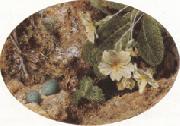 |
william henry hunt,o.w.s -- Click Here
|
|
1790-1864
was an English watercolour painter. He was born near Long Acre, London, and was apprenticed in about 1805 to John Varley, the landscape-painter, with whom he remained five or six years. He exhibited three oil pictures at the Royal Academy in 1807. He became connected with the Society of Painters in Water Colours at its beginning, and was elected an associate in 1824 and a full member in 1827. Until the year of his death, he was one of the most prolific contributors to the Society's exhibitions. Many years of Hunt's uneventful but industrious life were spent at Hastings. He died of apoplexy. Hunt was one of the creators of the English school of water-color painting. His subjects, especially those of his later life, are extremely simple; but, by the delicacy, humor and fine power of their treatment, they rank second to works of the highest art only. Considered technically, his works exhibit all the resources of the water-color painter's craft, from the purest transparent tinting to the boldest use of gouache, rough paper and scraping for texture. His sense of color is perhaps as true as that of any English artist. He was, says John Ruskin, all in all, the finest ever painter of still life. Several characteristic examples of Hunt's work, as the "Boy and Goat," "Brown Study and Plums," "Primroses and Birds' Nests" are in the Victoria and Albert Museum. |
|
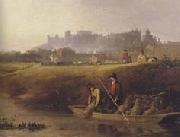 |
William henry hunt -- Click Here
|
|
English Painter, 1790-1864
was an English watercolour painter. He was born near Long Acre, London, and was apprenticed in about 1805 to John Varley, the landscape-painter, with whom he remained five or six years. He exhibited three oil pictures at the Royal Academy in 1807. He became connected with the Society of Painters in Water Colours at its beginning, and was elected an associate in 1824 and a full member in 1827. Until the year of his death, he was one of the most prolific contributors to the Society's exhibitions. Many years of Hunt's uneventful but industrious life were spent at Hastings. He died of apoplexy. Hunt was one of the creators of the English school of water-color painting. His subjects, especially those of his later life, are extremely simple; but, by the delicacy, humor and fine power of their treatment, they rank second to works of the highest art only. Considered technically, his works exhibit all the resources of the water-color painter's craft, from the purest transparent tinting to the boldest use of gouache, rough paper and scraping for texture. His sense of color is perhaps as true as that of any English artist. He was, says John Ruskin, all in all, the finest ever painter of still life. Several characteristic examples of Hunt's work, as the "Boy and Goat," "Brown Study and Plums," "Primroses and Birds' Nests" are in the Victoria and Albert Museum. |
|
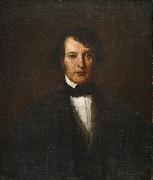 |
William Henry Furness -- Click Here
|
|
(1802-1896) was an American clergyman, theologian, reformer and abolitionist. Following the American Civil War, he raised funds for Black schools in the South, including Morehouse College.
A graduate of the Theological Department of Harvard University, Furness became the Minister of the First Unitarian Church of Philadelphia at the age of 22. A close friend of Ralph Waldo Emerson, Furness presided over a period marked by the growth and increasing prosperity for First Church. A fiery abolitionist, Furness was a supporter of the rights of all segments of society, including African-Americans and Jews. He also lived to see the construction of the current church building in 1885 in the role of Minister Emeritus.
Rev. Furness was the father of painter William Furness, Shakespearean scholar Horace Howard Furness, architect Frank Furness, and author and translator Annis Furness Lee.
|
|
 |
William Hays -- Click Here
|
|
May 9, 1819 C February 7, 1875 |
|
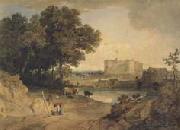 |
William Havell -- Click Here
|
|
English Painter, 1782-1857 |
|
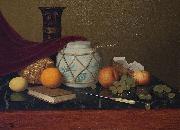 |
William Harnett -- Click Here
|
|
(August 10, 1848 - October 29, 1892) was an Irish-American painter known for his trompe l'oeil still lifes of ordinary objects.
Harnett was born in Clonakilty, County Cork, Ireland during the time of the potato famine. Shortly after his birth his family emigrated to America, settling in Philadelphia. Becoming a United States citizen in 1868, he made a living as a young man by engraving designs on table silver, while also taking night classes at the Pennsylvania Academy of the Fine Arts and later, in New York, at Cooper Union and at the National Academy of Design. His first known oil painting, a still life, dates from 1874.
|
|
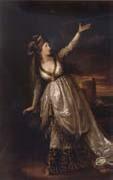 |
William Hamilton -- Click Here
|
|
English Painter, 1751-1801, was an English painter and illustrator. Hamiliton was born in Chelsea, London, but travelled and worked in Italy with Antonio Zucchi for several years. He trained first as an architectural draftsman, but soon moved to theatrical portraits and scenes from plays. Hamilton became very well known for his paintings depicting episodes from the plays of Shakespeare and for his illustrations of poems. He was commissioned to create works for John Boydell's Shakespeare Gallery, Macklin's Bible and Bowyer's English History. These were widely reproduced in popular prints. Francesco Bartolozzi engraved a number of Hamilton??s best known works. He also painted modern events, such as the execution of Marie Antoinette, in the manner of epic historical drama. Hamilton's style shows the influence of the cult of sentiment typical of the period, resembling the work of Angelica Kauffmann. He also sometimes adopts aspects of Fuseli's dramatic distortions in composition and figure drawing. He became an associate member of the Royal Academy from 1784, and was made a full member in 1789. |
|
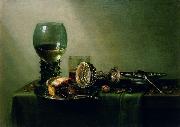 |
Willem Claesz. Heda -- Click Here
|
|
painted Dessert in 1637 |
|
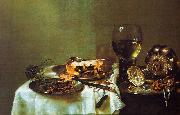 |
Willem Claesz Heda -- Click Here
|
|
1594-1682
Dutch
Willem Claesz Heda Galleries
Dutch painter. He was a still-life painter, who, like Pieter Claesz., is noted for his monochrome breakfast-pieces, which are, however, more opulent than those of Claesz. Heda earliest dated work is a Vanitas (1621; The Hague, Mus. Bredius), which shows a still-life from a high viewpoint, composed of various objects bearing vanitas associations (e.g. a bowl of glowing embers, smoker requisites, an overturned glass and a skull); the colouring is in brownish-grey tones and represents one of the earliest examples of a Dutch monochrome still-life (monochrome refers to the range of tones, rather than of colours). Even in this early work Heda skill at painting textures is evident. A more balanced composition is achieved in another Still-life (1629; The Hague, Mauritshuis) and in the Breakfast Table (1631; Dresden, Gemeldegal. Alte Meister), in both of which the objects, set against a neutral background, are linked by a strong diagonal. The Mauritshuis still-life also gives an early indication of Heda interest in painting the effects of light. In 1631 he became a member of the Haarlem Guild of St Luke (of which he served as deacon on several occasions after 1637). |
|
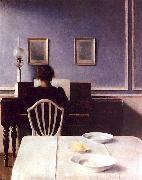 |
Wilhelm Hammershoi -- Click Here
|
|
Danish 1864-1916
The son of a well-to-do merchant, Christian Hammershøi and his wife, Frederikke (n??e Rentzmann), Vilhelm studied drawing from the age of eight with Neils Christian Kierkegaard and Holger Grønvold, as well as painting with Vilhelm Kyhn, before embarking on studies with Frederik Vermehren and others at the Royal Danish Academy of Fine Arts. From 1883 to 1885, he studied with Peder Severin Krøyer at the Independent Study Schools, then debuted in the Charlottenborg Exhibition in the spring of 1885 with Portrait of a Young Girl (his sister, Anna; Pierre Auguste Renoir is reported to have admired this painting). Hammershøi married Ida Ilsted in 1891. |
|
 |
Wilfred vincent herbert -- Click Here
|
|
fl.1863-1891
Parce Alteri |
|
|
|
|
|
 |
VROOM, Hendrick Cornelisz. -- Click Here
|
|
Dutch Baroque Era Painter, ca.1563-1640. He was one of the founders of Dutch marine painting. Painter and draughtsman. By his own account, he received his early training in Delft, home of his mother's family. Van Mander reports that Hendrick's stepfather, like his father a ceramic artist, forced him to work as a decorator of ceramic vessels, which caused the young artist to leave home and embark on extensive travels in Spain and Italy. After working for ecclesiastical patrons in Florence and Rome, he was employed for at least two years (c. 1585-7) by Cardinal Ferdinando de' Medici, who in October 1587 succeeded Francesco I as Grand Duke of Tuscany. Ferdinando's keen interest in ships and the navy seems to have been a determining factor in Vroom's choice of subject-matter. According to Lanzi, he was known in Rome as 'Lo Spagnolo' (since he had arrived there from Spain). Among his earliest works may be a group of marine paintings attributed to him (Rome, Villa Colonna). His friendship in Rome with Paul Bril, mentioned by van Mander, had no effect on Hendrick's painting style, but Bril's influence is discernible in a group of landscape drawings |
|
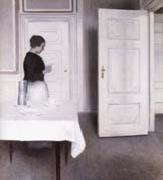 |
Vilhelm Hammershoi -- Click Here
|
|
Danish Painter, 1864-1916, was a painter born in Copenhagen, Denmark known for his poetic, low-key portraits and interiors.The son of a well-to-do merchant, Christian Hammershoi and his wife, Frederikke (nee Rentzmann), Vilhelm studied drawing from the age of eight with Neils Christian Kierkegaard and Holger Gronvold, as well as painting with Vilhelm Kyhn, before embarking on studies with Frederik Vermehren and others at the Royal Danish Academy of Fine Arts. From 1883 to 1885, he studied with Peder Severin Kroyer. |
|
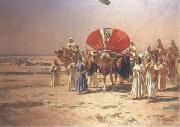 |
Victor Huguet -- Click Here
|
|
French Painter, 1835-1902 |
|
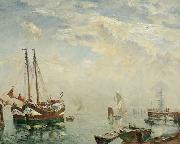 |
Ulrich Hubner -- Click Here
|
|
(17 June 1872 Berlin - 29 April 1932 Neubabelsberg) was a German painter.
He was born into a family of artists, his academic training he received in 1892 in Karlsruhe with Robert Poetzelberger, Gustav Schönleber, and Carlos Grethe. He then studied at the private art school in Munich Friedrich Fehr. In 1899, he was a member of the Berlin Secession, and in 1906 and 1907 was on the board.
In 1899, he won the prize for advertising designs for cooperative advertising by Ludwig and Otto Stollwerck Henkell.
He painted in Berlin, Havel, and in the summers in Hamburg, Lebeck, Rostock and Travemende (where he had his principal residence from 1909 to 1912), and in particular, many harbor scenes.
He showed at Kunstverein in Hamburg in 1910. Some of his works are in the Behnhaus Museum, in Lebeck, and Los Angeles County Museum of Art.
|
|
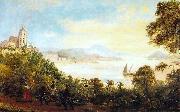 |
Thomas Lyde Hornbrook -- Click Here
|
|
painted Vista do Outeiro da Gloria in 1838 |
|
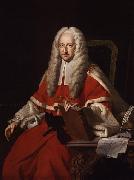 |
Thomas Hudson -- Click Here
|
|
Thomas Hudson (1701 - 1779) was an English portrait painter in the 18th century. He was born in 1701 in the West Country of the United Kingdom. His exact birthplace is unknown. Hudson studied under Jonathan Richardson in London and against his wishes, married Richardson's daughter at some point before 1725.
Hudson was most prolific between 1740 and 1760 and, from 1745 until 1755 was the most successful London portraitist. He lived at Deep Cross, Twickenham.
Many assistants were employed by Hudson, to help with his paintings. Joshua Reynolds and Joseph Wright were students of Hudson. He retired toward the end of the 1750s. |
|
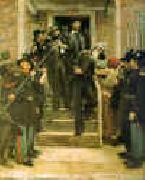 |
Thomas Hovenden -- Click Here
|
|
1840-1895
Thomas Hovenden Gallery
Thomas Hovenden (December 28, 1840 ?C August 14, 1895), was an Irish-American artist and teacher. He painted realistic quiet family scenes, narrative subjects and often depicted African Americans.
Hovenden was born in Dunmanway, Co. Cork, Ireland. His parents died at the time of the potato famine and he was placed in an orphanage at the age of six. Apprenticed to a carver and gilder, he studied at the Cork School of Design.
In 1863, he immigrated to the United States. He studied at the National Academy of Design in New York City. He moved to Baltimore in 1868 and then left for Paris in 1874. He studied at the École des Beaux Arts under Cabanel, but spent most of his time with the American colony at Pont-Aven in Brittany led by Robert Wylie, where he painted many pictures of the peasantry.
Returning to America in 1880, he became a member of the Society of American Artists and an Associate member of the National Academy of Design (elected Academician in 1882). He married Helen Corson in 1881, an artist he had met in Pont-Aven, and settled at her father's homestead in Plymouth Meeting, Pennsylvania, outside of Philadelphia. She came from a family of abolitionists and her home was a stop on the underground railroad. Their barn, later used as Hovenden's studio, was known as Abolitionist Hall due to its use for anti-slavery meetings.
He was commissioned to paint a historical picture of the abolitionist leader John Brown. He finished "The Last Moments of John Brown" (now in the collection of the Fine Arts Museums of San Francisco) in 1884. His "Breaking Home Ties", a picture of American farm life, was engraved with considerable popular success.
In 1886, he was appointed Professor of Painting and Drawing at the Pennsylvania Academy of the Fine Arts, replacing Thomas Eakins who was dismissed due to his use of nude models. Among Hovenden's students were the sculptor Alexander Stirling Calder and the leader of the Ashcan School, Robert Henri.
Hovenden was killed at the age of 54, along with a ten-year old girl, by a railroad locomotive at a crossing near his home in Plymouth Meeting. Newspaper accounts reported that his death was the result of a heroic effort to save the girl, while a coroner's inquest determined his death was an accident. |
|
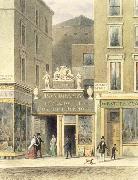 |
Thomas Hosmer Shepherd -- Click Here
|
|
(1793-1864), British printmaker and painter |
|
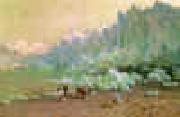 |
Thomas Hill -- Click Here
|
|
1829-1908
Thomas Hill was born in England on September 11, 1829. At the age of 15, he emigrated to the United States with his family. They settled in Taunton, Massachusetts. In 1851, he married Charlotte Elizabeth Hawkins. They had nine children.
At the age of 24, Hill attended evening classes at the Pennsylvania Academy of the Fine Arts (PAFA) and studied under American painter Peter Frederick Rothermel (1812-1895). During his years as a student, Hill traveled to the White Mountains in New Hampshire as early as 1854 and sketched alongside members of the Hudson River School, such as Benjamin Champney. In 1856, Hill and his family moved to San Francisco, California.
With painter Virgil Williams and photographer Carleton Watkins, Hill made his first trip to the Yosemite Valley in 1865. The next year, Hill traveled to the East Coast and Europe. He established his family on the East Coast but continued to take sketching trips to the West Coast and to attend meetings of the San Francisco Art Association. He moved his family back to San Francisco in 1873.
Hill made yearly sketching trips to Yosemite, Mount Shasta, and, back east, to the White Mountains. Hill ran an art gallery and art supply store. He briefly acted as the interim director for the SFAA School of Design and went to Alaska on a commission for environmentalist John Muir. He lived on his stock market investments as well as his art proceeds. His marriage ended in the 1880s.
Toward the end of his life, he maintained a studio at Yosemite??s Wawona Hotel. After suffering a stroke, Hill left Yosemite and traveled up and down the California coast, including stops in Coronado, San Diego and Santa Barbara. He died in Raymond, California, on June 30, 1908, and is buried at Mountain View Cemetery in Oakland, California. |
|
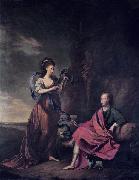 |
Thomas Hickey -- Click Here
|
|
was an Irish painter.
Born in Dublin, Hickey was the son of Noah, a confectioner in Capel Street, and Anne Hickey. A younger brother was John Hickey, the sculptor. He was trained at the Royal Dublin Society schools under Robert West.
Hickey painted primarily portraits and genre scenes. He traveled widely, working in India, Portugal, Italy and England, residing in Bath between 1776 and 1780. On his voyage to India, the vessel in which he was travelling was captured by French and Spanish fleets which led him to Lisbon, where, after receiving a number of commissions, he remained for several years. He eventually reached Bengal and stayed there until 1791 when he returned to England. He then traveled as far as Peking, China with George Macartney, 1st Earl Macartney as the expedition's official portrait painter.
He returned to Ireland shortly after the death of his brother John in January 1796. In 1797, he was commissioned by Dr. Robert Emmet, State Physician for Ireland, to paint a portrait of the doctor's son, Robert, and daughter, Mary. By 1798 he had returned to India where he landed just in time for the start of the Fourth Mysore War, which kept him engaged in painting. He resided in Madras until his death in 1824.
In addition to his artistic talents, he is reputed to have been a sparkling conversationalist who rarely failed to charm his sitters. The Courtauld Institute of Art (London), the Honolulu Academy of Arts, the National Gallery of Ireland, the Tate and the Victoria Art Gallery (Bath, England) are among the public collections having paintings by Thomas Hickey. |
|
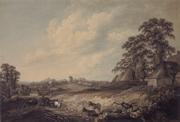 |
Thomas Hearne -- Click Here
|
|
British Painter, 1744-1817
English painter and engraver. From 1765 to 1771 Hearne studied printmaking as apprentice to the landscape engraver William Woollett, exhibiting watercolours meanwhile at the Free Society of Artists and the Society of Artists. In 1771 he abandoned engraving and accompanied Sir Ralph Payne to the Leeward Islands (where Payne had just been appointed Governor), returning in 1775; several of his fastidious watercolours of Antigua survive, for example the Court House and Guard House in the Town of St John's in the Island of Antigua (n.d.; London, V&A). From then on British topography was his main concern. He travelled widely in England, Scotland and Wales with Sir George Beaumont and from these excursions was able to provide 84 drawings which, engraved by William Byrne, were published as The Antiquities of Great Britain (1778-81). This series set new standards in the pictorial recording of medieval architecture. Hearne also provided drawings for etchings of landscapes and 'rural sports'. |
|
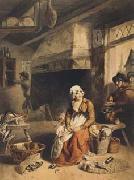 |
Thomas Heaphy -- Click Here
|
|
English Painter, 1775-1835
He trained at John Boyne's drawing school in Gloucester Street, Bloomsbury, London, and exhibited portraits at the Royal Academy from 1797. Following the success of a portrait of the Russian ambassador, Count Woronzow, he was appointed portrait painter to the Princess of Wales. Thomas Lawrence observed Heaphy's success and bought some of his pictures but had little cause to envy Heaphy's style, which owed much to the vocabulary of civic portraiture popularized by Joshua Reynolds (e.g. Portrait of a Naval Officer; London, V&A). Heaphy's largest project, The Duke of Wellington in Consultation with his Officers Previous to a General Engagement (Newcastle upon Tyne, Laing A.G.), was begun in Spain in 1813 during the Peninsular War and was finished in 1816. The engraving, which was intended to ensure Heaphy's fortune, was not released until 1822, by which time interest in the war had waned. Heaphy failed to finish his Battle of Waterloo (1816; untraced), another panoramic multiple portrait. Heaphy's other speciality, paintings of ports, markets, tradespeople and labourers, brought him great popularity between 1807 and 1811. |
|
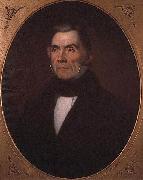 |
Theophile Hamel -- Click Here
|
|
(8 November 1817 - 23 December 1870) was a Canadian artist who painted mainly portraits and religious images in 19th-century Quebec.
Hamel was born in 1817 in Sainte-Foy (that was a suburb of Quebec City), the son of a successful farmer. Hamel's paternal ancestry can be traced to French immigrant Jean Hamel, who arrived in New France from Avremesnil (Normandy) in 1656. In 1834 Theophile was already taking art lessons from Antoine Plamondon. His early portraits show a mixture of European romanticism and Canadian simplicity. His style gradually changed to match the taste of his clients for simple, honest, even prim portraits |
|
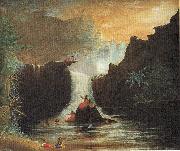 |
Theodore Heuck -- Click Here
|
|
(1830 - 1877) was an architect, a merchant, and a painter. He designed The Queen's Medical Center (dedicated to Queen Emma), the Royal Mausoleum of Hawaii in 1865, and ʻIolani Barracks in 1871.
He was born in Hamburg, Germany and grew up as an only child. Traveling from Australia, Heuck arrived in Hawaii January 20, 1850 and advertised as the first professional architect. Finding no business, he became a partner with Herman Von Halt in a retail store, "General Commission Merchants". He became a citizen of the Kingdom of Hawaii and married Mahiki on March 22, 1852 |
|
|
|
Theodore Henry Fielding -- Click Here
|
|
Fielding, TH (Theodore Henry), 1781-1851 |
|
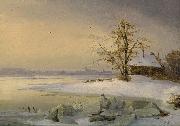 |
Theodor Hosemann -- Click Here
|
|
painted Blick uber die Havel auf das winterliche Brandenburg in 1838 |
|
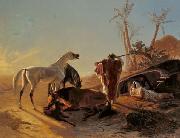 |
Theodor Horschelt -- Click Here
|
|
(1829 -1871 ) - Watercolours |
|
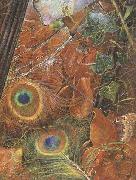 |
The Hon.Eleanor Vere Boyle -- Click Here
|
|
1825-1916
|
|
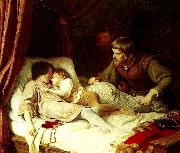 |
th. hildebrandt -- Click Here
|
|
Ferdinand Theodor Hildebrandt, född 2 juli 1804 i Stettin, död 29 september 1874 i Dusseldorf, var en tysk målare.
Hildebrandt började sina konstnärliga studier i Berlin under Wilhelm Schadow, vilken han 1826 följde till Dusseldorf, och blev en av den där grundade skolans mest framstående lärjungar. 1825 framträdde han med Faust, 1826 med Cordelia och kung Lear och 1828 med Tankred döpande Klorinda. Ännu större popularitet vann han 1835 för Mordet på kung Edvards söner. Bland hans genrebilder har i synnerhet Krigaren och hans son (1832, Berlins nationalgalleri) blivit känd. Hildebrandt, som för övrigt utförde illustrationer och porträtt, kallades på sin tid realist, men han var knappast fri från den melodramatiska ton och den sentimentala inställning, som tillhörde skolan. |
|
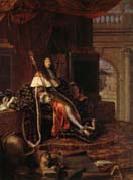 |
Testelin,Henri -- Click Here
|
|
French , 1616-1695
Painter, printmaker and writer, brother of Louis Testelin. As a member of the circle of Charles Le Brun, he endorsed his connection with the Academie Royale by submitting an allegorical portrait of Louis XIV in Childhood as Patron of the Arts as his morceau de reception. He was secretary of the Acad?mie from 1650 and a professor from 1656. He produced several tapestry cartoons based on designs by Le Brun for the Gobelins, including the Wedding of Louis XIV and Maria-Theresa on 9 June 1660 (before 1665) and the Founding of the Academie des Sciences and the Observatory in 1666. He was active also as a court portrait painter, exhibiting portraits of Louis XIV as Patron of the Academie Royale de Peinture et de Sculpture (exh. Salon 1673; Versailles, Cheteau) and of Maria-Theresa, Queen of France . Also at the Salon of 1673 he showed a history painting, |
|
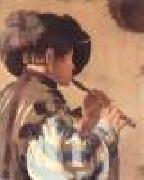 |
TERBRUGGHEN, Hendrick -- Click Here
|
|
Dutch Baroque Era Painter, ca.1588-1629
Dutch painter, a leading member of the Utrecht school. He was a pupil of the history painter Bloemaert before living (c.1604?C14) in Italy. Crowning of Thorns (1620; Copenhagen) is his first known dated work. Like his contemporaries Honthorst and Baburen, he was largely influenced by Caravaggio, although an awareness of D??rer and Lucas van Leyden recurs throughout his work. His intimate and restrained genre compositions foreshadow in coloring the work of Vermeer. Many of Terbrugghen's paintings are nighttime genre scenes. His work is represented in the major European museums. Typical examples are his St. Sebastian (Allen Mus., Oberlin, Ohio), Old Man Writing |
|
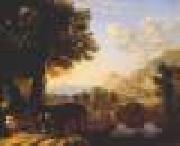 |
SWANEVELT, Herman van -- Click Here
|
|
Dutch Baroque Era Painter, ca.1600-1655
Dutch painter, draughtsman and etcher, active in France and Italy. His first signed and dated works are two views of Paris dated 1623 (Brunswick, Herzog Anton Ulrich-Mus.). He was in Rome from 1629 to 1641. His earliest dated painting there is an Old Testament Scene (1630; The Hague, Mus. Bredius; see fig.), a compositional formula that he often used, with some variations, in Rome. A flat, low foreground is closed on the left by a house and a tree; on the right is a distant hilly scene; and groups of figures are disposed horizontally. This design, derived from Cornelis van Poelenburch, is well suited to van Swanevelt's many landscapes with biblical and mythological subjects. The large tree extending beyond the frame gives a monumental touch to the composition. |
|
|
|
 |
STRIGEL, Hans II -- Click Here
|
|
German painter, Swabian school (active 1450-1480 in Memmingen). Painter. The panels of the Montfort-Werdenberg Altarpiece and a Deposition mural (1477), fragment of a series in the church at Tiefenbach, Allgäu, are documented as his. They show an artist in the tradition of Hans Multscher, using strongly foreshortened perspectives for an emphatic relaying of realities. In the 1470s he attempted to tone down the contrasts, to organize his figures after the manner of the Master of Sterzing: a change of style shown in the panels of the Mickhausener altar (Budapest, Mus. F.A.) and the Saints and Passion scenes in the Oberhaus-Museum |
|
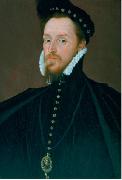 |
Steven van Herwijck -- Click Here
|
|
(Utrecht c. 1530-London 1565/67), was a Netherlandish sculptor and gem engraver famous for his portrait medallions and medals. It has recently been suggested that he is the "famous paynter Steven" mentioned in an inventory of 1590, who has traditionally been identified as Steven van der Meulen.
Van Herwijck worked in Italy in 1557 and returned to Utrecht in 1558, when he was made a Master of the artists' Guild of St. Luke. His earliest surviving medals, of George van Egmond, Bishop of Utrecht, and Engelken Tols, date from this year. In 1559 he relocated to Antwerp. Nine medals survive of his work there, including a portrait of Jacobus Fabius. Fleeing religious persecution, he went to Poland in 1561 where he made medallions of King Sigismund II and other members of the Polish royal family. |
|
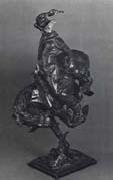 |
Solon H. Borglum -- Click Here
|
|
American Sculptor, 1868-1922,was an American sculptor. Born in Ogden, Utah, he was the younger brother of Gutzon Borglum and uncle of Lincoln Borglum of Mount Rushmore fame. The son of Danish immigrants who settled on the great plains, Solon Borglum spent his early years as a rancher in western Nebraska. Though he later lived in Paris and New York and achieved a reputation as one of America's best sculptors, it was his depiction of frontier life, and especially his experience with cowboys and native American peoples, on which his reputation was founded. Borglum studied under Louis Rebisso in Cleveland and in Paris. He specialized in depicting people and scenes of the American West. He moved to the Silvermine neighborhood of New Canaan, Connecticut, where he helped found the "Knockers Club" of artists. His brother, Gutzon, lived in nearby Stamford, |
|
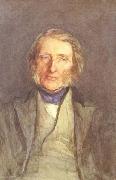 |
Sir Hubert von Herkomer,RA,RWS -- Click Here
|
|
1849-1914
|
|
|
|
sir herbert edwin pelham hughes-stanton,r.a.,p.r.w.s. -- Click Here
|
|
1870-1937 |
|
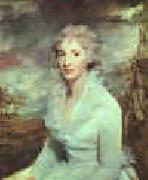 |
Sir Henry Raeburn -- Click Here
|
|
1756-1823
Scottish Sir Henry Raeburn Galleries
He was born the son of a manufacturer in Stockbridge, a former village now within the city of Edinburgh. Orphaned, he was supported by his older brother and placed in Heriot's Hospital, where he received an education. At the age of fifteen he was apprenticed to a goldsmith, and various pieces of jewellery, mourning rings and the like, adorned with minute drawings on ivory by his hand, still exist. Soon he took to the production of carefully finished portrait miniatures; meeting with success and patronage, he extended his practice to oil painting, at which he was self-taught. The goldsmith watched the progress of his pupil with interest, and introduced him to David Martin, who bad been the favourite assistant of Allan Ramsay the Latter, and was now the leading portrait painter in Edinburgh. Raeburn was especially aided by the loan of portraits to copy. Soon he had gained sufficient skill to make him decide to devote himself exclusively to painting.
In his early twenties, he was asked to paint the portrait of a young lady whom he had previously observed and admired when he was sketching from nature in the fields. She was the daughter of Peter Edgar of Bridgelands, and widow of Count Leslie. Fascinated by the handsome and intellectual young artist, she became his wife within a month, bringing him an ample fortune. The acquisition of wealth did not affect his enthusiasm or his industry, but spurred him on to acquire a thorough knowledge of his craft. It was usual for artists to visit Italy, and Raeburn set off with his wife. In London he was kindly received by Sir Joshua Reynolds, who advised him on what to study in Rome, especially recommending the works of Michelangelo. Raeburn carried with him to Italy many valuable introductions from the president of the Royal Academy. In Rome he met Gavin Hamilton, Pompeo Girolamo Batoni and Byers, an antique dealer whose advice proved particularly useful, especially the recommendation that "he should never copy an object from memory, but, from the principal figure to the minutest accessory, have it placed before him." After two years of study in Italy he returned to Edinburgh in 1787, and began a successful career as a portrait painter. In that year he executed a seated portrait of the second Lord President Dundas.
Raeburn's portrait of Sir Walter Scott (1822)Examples of his earlier portraiture include a bust of Mrs Johnstone of Baldovie and a three-quarter-length of Dr James Hutton, works which, if somewhat timid and tentative in handling and not as confident as his later work, nevertheless have delicacy and character. The portraits of John Clerk, Lord Eldin, and of Principal Hill of St Andrews belong to a later period. Raeburn was fortunate in the time in which he practised portraiture. Sir Walter Scott, Hugh Blair, Henry Mackenzie, Lord Woodhouselee, William Robertson, John Home, Robert Fergusson, and Dugald Stewart were resident in Edinburgh, and were all painted by Raeburn. Mature works include his own portrait and that of the Rev. Sir Henry Moncrieff Wellwood, the bust of Dr Wardrop of Torbane Hill, the two full-lengths of Adam Rolland]] of Gask, the remarkable paintings of Lord Newton and Dr Alexander Adam in the National Gallery of Scotland, and that of William Macdonald of St Martin's.
It was commonly believed that Raeburn was less successful in painting female portraits, but the exquisite full-length of his wife, the smaller likeness of Mrs R. Scott Moncrieff in the National Gallery of Scotland, and that of Mrs Robert Bell, and others, argue against this. Raeburn spent his life in Edinburgh, rarely visiting London, and then only for brief periods, thus preserving his individuality. Although he, personally, may have lost advantages resulting from closer association with the leaders of English art, and from contact with a wider public, Scottish art gained much from his disinclination to leave his native land. He became the acknowledged chief of the school which was growing up in Scotland during the earlier years of the 19th century, and his example and influence at a critical period were of major importance. So varied were his other interests that sitters used to say of him, "You would never take him for a painter till he seizes the brush and palette."
In 1812 he was elected president of the Society of Artists in Edinburgh, in 1814 associate, and in the following year full member of the Royal Scottish Academy. In 1822 he was knighted by George IV and appointed His Majesty's limner for Scotland. He died at Edinburgh.
The Reverend Robert Walker Skating on Duddingston Loch, better known as The Skating Minister (1790s)Raeburn had all the essential qualities of a popular and successful portrait painter. He was able to produce a telling and forcible likeness; his work is distinguished by powerful characterisation, stark realism, dramatic and unusual lighting effects, and swift and broad handling of the most resolute sort. David Wilkie recorded that, while travelling in Spain and studying the works of Diego Vel??zquez, the brushwork reminded him constantly of the "square touch" of Raeburn.
Raeburn was unusual amongst many of his contemporaries, such as Reynolds, in the extent of his philosophy of painting everything directly from life. This attitude partly explains the often coarse modelling and clashing colour combinations he employed, in contrast to the more refined style of Thomas Gainsborough and Reynolds. However these qualities and those mentioned above anticipate many of the later developments in painting of the nineteenth century from romanticism to Impressionism.
Sir Henry Raeburn died in St Bernard's House, Stockbridge, Edinburgh. |
|
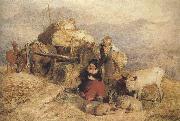 |
Sir edwin henry landseer,R.A. -- Click Here
|
|
1802-1873
Painter, draughtsman, sculptor and etcher, brother of (3) Charles Landseer. He became the best-known member of the family and was one of the most highly respected and popular British painters of the 19th century. He was first trained by his father, who taught him etching, and he then studied with Benjamin Robert Haydon and at the Royal Academy Schools in London. Precociously gifted, he drew competently from childhood and in 1813 he won the Silver Palette for draughtsmanship at the Society of Arts. In 1815 he exhibited at the Royal Academy for the first time, showing some drawings of a mule and of the heads of dogs. From an early age he was a frequent visitor to the menagerie in Exeter Change in the Strand, London, |
|
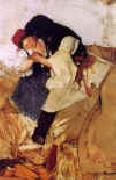 |
Simon Hollosy -- Click Here
|
|
1857-1918
Hungarian Simon Hollosy Gallery
Simon Hollosy (Romanian: Simion Corbu); (2 February 1857, Maramarossziget, now Sighetu Marmatiei - 8 May 1918, Tecso, now Tiachiv) was a Hungarian painter. He was considered one of the greatest Hungarian representatives of 19th century Naturalism and Realism.
Holl??sy came from an Armenian family who settled in Maramarossziget (present-day Sighetu Marmaţiei, Romania). He frequently worked abroad.
He criticized training at the Academy and founded a private school in 1886 where he gathered young talents around him who were interested in realistic protrayal. He opened the way to new styles by relying on his personality and by pointing out the merits of French pictures (Courbet) exhibited in Munich. He abandoned the academic style in order to follow new trends in French painting.
Encouraged by Istvan Reti and Janos Thorma, his pupils and friends, he spent the summer of 1896 in Nagyb??nya (present-day Baia Mare, Romania) with his school, which played an important role in Hungarian painting as the cradle of the Nagybanya school. He soon settled down in Nagybanya. With its style (sunny landscapes), his school determined Hungarian painting for decades. Leaving the Nagyb??nya colony in 1901, he spent the summers in Tecso with his students from 1902. During winters he was in Munich to run his school there.
He was not productive as an artist: he was in search of atmospheres and his productivity was confined to teaching. His large scale plan of "Rakoczi March" with a lot of figures got as far sketches because he kept on changing his mind. The landscapes painted in Tecso include "Landscape in T??cső", "Landscape with Stacks and Sunset with Stacks", where he applied elements of plein air and impressionism.
His self-portrait (1916) is one of his most harrowing pictures. |
|
 |
SEGHERS, Hercules -- Click Here
|
|
Dutch Baroque Era Painter and Printmaker, ca.1590-1638
Dutch landscape painter and etcher. Seghers's work greatly influenced early 17th-century Dutch landscape painting. He studied with the painter Coninxloo (1544C1607) and may have traveled to Italy and in the Alps. Some of the frenzy of his personal life can be seen in his rare paintings and his more numerous, masterly etchings. His landscapes consist of vast, often desolate, panoramas and powerful, smaller scenes rendered with drama and pathos. Rembrandt owned eight paintings by him, and his own landscape style was influenced by Seghers. |
|
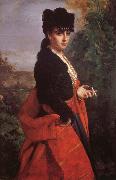 |
Schlesinger Henri Guillaume -- Click Here
|
|
French portraits and genre painter , 1846-1884
|
|
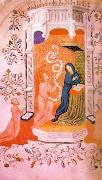 |
SCHEERE, Herman -- Click Here
|
|
German miniaturist ,
active 1403-1419 in England |
|
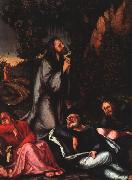 |
SCHAUFELEIN, Hans Leonhard -- Click Here
|
|
German Northern Renaissance Painter, ca.1480-1540
was a German painter, designer, and wood engraver. He was born in Nuremberg, probably studied under Wohlgemut, and then became the assistant of D??rer, whom he imitated. In 1512 he went to Augsburg and in 1515 removed to Nordlingen. He is a graceful narrator, and his types, though rarely accurately drawn, are attractive, but he lacks power and depth. Characteristic early paintings are the altarpiece at Ober Sankt Veit[1], near Vienna (1502), "Scenes from the Life of Christ" (Dresden Gallery), and "St. Jerome" (Germanic Museum, Nuremberg). To his Nordlingen period belong his masterpiece, the so-called "Ziegler Altar" for St. George's Church (1521), part of which is still in the church, part in the museum; "Scenes from the Story of Judith," in the town hall; and the illuminated Psalter for Count von Ottingen, now in the Berlin print room. His most important woodcuts are those for the Theuerdank of Emperor Maximilian. |
|
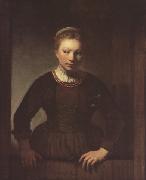 |
Samuel van hoogstraten -- Click Here
|
|
Dutch Baroque Era Painter, 1627-1678
Dutch portrait painter and etcher, studied with his father, Dirk van Hoogstraten (1596?C1640), and with Rembrandt. His best works, such as The Old Jew (Vienna), reflect the influence of Rembrandt. He was director of the Academy in Dordrecht and author of a treatise (1678) in which he analyzed the theory and practice of the art of Rembrandt and other artists of the period. |
|
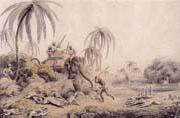 |
Samuel Howitt -- Click Here
|
|
English, 1756-1822,was an artist from England. Samuel Howitt was born into a wealthy Quaker family in Nottinghamshire, England. He began painting as a hobby and to amuse his friends. Hunting and racing were his hobbies and he mimicked this interest in his work. Howitt's family experienced financial difficulties, so Howitt decided to move to London. In London, Howitt made a career out of his talent, flourishing as a professional artist. He was published often in The Sporting Magazine and went on to illustrate various books. Howitt is best known for his lively and exotic sporting scenes. His superior watercolors and aquatints depict dramatic racing and hunting scenes as well as an array of conventional and exotic animals. Howitt's work is included in the Mellon Collection, which possesses no fewer than 160 of his watercolors, and many of his aquatints. Howitt exhibited at the Royal Academy and illustrated several books, including his own entitled The British Sportsman c.1812 and British Preserve c.1824. Samuel Howitt, "genius, artist, sportsman", concentrated his considerable artistic talents on picturing scenes of horse-racing and hunting in all its aspects. Born in Nottinghamshire, England, Howitt was largely self-taught ,"although he must have been helped by his companions George Morland, Rowlandson and John Raphael Smith. Howitt's watercolours of hunting, shooting and racing have delightful spontaneity. |
|
 |
Samuel Hieronymous Grimm -- Click Here
|
|
Swiss Painter, 1733-1794
Swiss painter and draughtsman, active in England. He studied in Berne under Johann Ludwig Aberli and became established as a painter of topographical views in oil and watercolour. His early surviving works (e.g. River Landscape and Landscape with Chasseurs; Basle, priv. col.) are principally tinted drawings of landscapes and alpine scenery, with scenes of rustic life in the foreground; they display his characteristically charming and informal style. He also produced many decorative book illustrations: the frontispiece and plates to Friedrich von Hagedorn's Poetische Werke (1769-72) are among his finest. By 1764 Grimm had abandoned oils and was painting only in watercolour. From 1765 to 1768 he travelled and painted in France; he then moved to England, |
|
|
|
|
| | |
|
|
|
|